tow Citroen BERLINGO FIRST 2011.5 1.G User Guide
[x] Cancel search | Manufacturer: CITROEN, Model Year: 2011.5, Model line: BERLINGO FIRST, Model: Citroen BERLINGO FIRST 2011.5 1.GPages: 128, PDF Size: 3.68 MB
Page 73 of 128
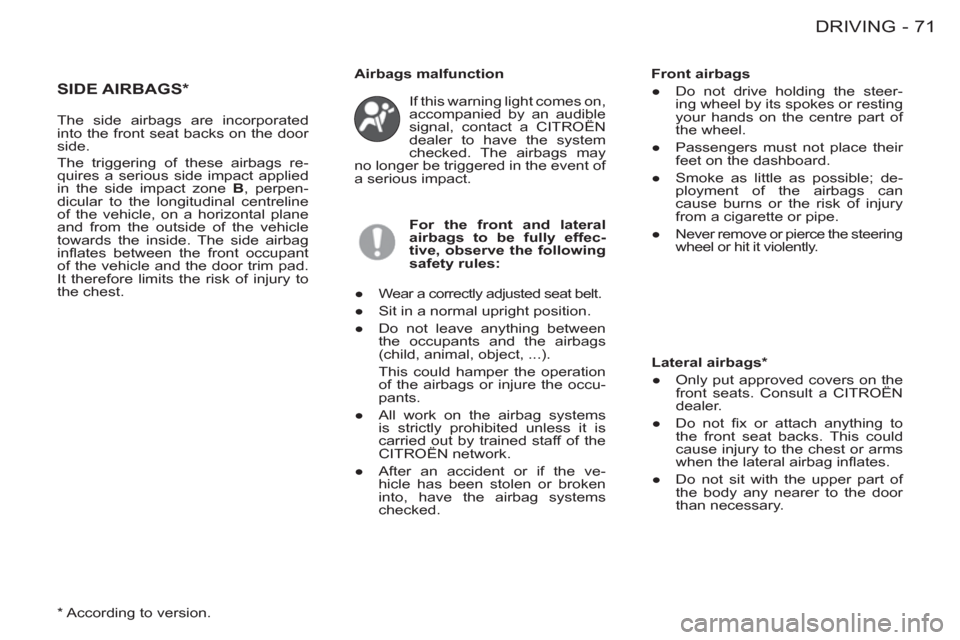
71 DRIVING
-
SIDE AIRBAGS *
If this warning light comes on,
accompanied by an audible
signal, contact a CITROËN
dealer to have the system
checked. The airbags may
no longer be triggered in the event of
a serious impact.
Airbags malfunction
For the front and lateral
airbags to be fully effec-
tive, observe the following
safety rules:
●
Wear a correctly adjusted seat belt.
●
Sit in a normal upright position.
●
Do not leave anything between
the occupants and the airbags
(child, animal, object, ...).
This could hamper the operation
of the airbags or injure the occu-
pants.
●
All work on the airbag systems
is strictly prohibited unless it is
carried out by trained staff of the
CITROËN network.
●
After an accident or if the ve-
hicle has been stolen or broken
into, have the airbag systems
checked.
Front airbags
●
Do not drive holding the steer-
ing wheel by its spokes or resting
your hands on the centre part of
the wheel.
●
Passengers must not place their
feet on the dashboard.
●
Smoke as little as possible; de-
ployment of the airbags can
cause burns or the risk of injury
from a cigarette or pipe.
●
Never remove or pierce the steering
wheel or hit it violently.
Lateral airbags *
●
Only put approved covers on the
front seats. Consult a CITROËN
dealer.
●
Do not fi x or attach anything to
the front seat backs. This could
cause injury to the chest or arms
when the lateral airbag infl ates.
●
Do not sit with the upper part of
the body any nearer to the door
than necessary.
The side airbags are incorporated
into the front seat backs on the door
side.
The triggering of these airbags re-
quires a serious side impact applied
in the side impact zone B
, perpen-
dicular to the longitudinal centreline
of the vehicle, on a horizontal plane
and from the outside of the vehicle
towards the inside. The side airbag
infl ates between the front occupant
of the vehicle and the door trim pad.
It therefore limits the risk of injury to
the chest.
*
According to version.
Page 78 of 128

Partners in performance and
protecting the environment
Innovation in the search for
performance
For over 40 year, the TOTAL Research
and Development departments have
developed for CITROËN, lubricants to
match the latest technical innovations on
CITROËN vehicles, both for competition
and for everyday motoring.
For you, this is an assurance that you will
obtain of the best performance for your en-
gine.
Optimum protection for your
engine
By having your CITROËN vehicle
serviced with TOTAL lubricants,
you are contributing towards
improving the life and perform-
ances of your engine, while also
protecting the environment.
prefers
Page 80 of 128
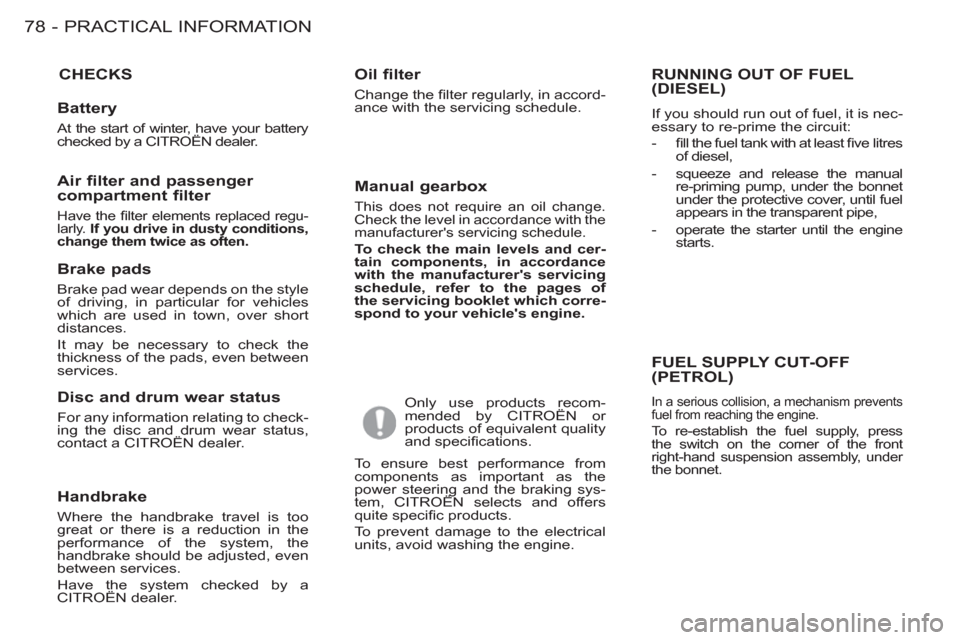
PRACTICAL INFORMATION
78 -
CHECKS
Oil filter
Change the fi lter regularly, in accord-
ance with the servicing schedule.
Only use products recom-
mended by CITROËN or
products of equivalent quality
and specifi cations.
To ensure best performance from
components as important as the
power steering and the braking sys-
tem, CITROËN selects and offers
quite specifi c products.
To prevent damage to the electrical
units, avoid washing the engine.
RUNNING OUT OF FUEL (DIESEL)
If you should run out of fuel, it is nec-
essary to re-prime the circuit:
- fi ll the fuel tank with at least fi ve litres
of diesel,
- squeeze and release the manual
re-priming pump, under the bonnet
under the protective cover, until fuel
appears in the transparent pipe,
- operate the starter until the engine
starts.
FUEL SUPPLY CUT-OFF(PETROL)
In a serious collision, a mechanism prevents
fuel from reaching the engine.
To re-establish the fuel supply, press
the switch on the corner of the front
right-hand suspension assembly, under
the bonnet.
Air filter and passenger
compartment filter
Have the fi lter elements replaced regu-
larly. If you drive in dusty conditions,
change them twice as often.
Brake pads
Brake pad wear depends on the style
of driving, in particular for vehicles
which are used in town, over short
distances.
It may be necessary to check the
thickness of the pads, even between
services.
Disc and drum wear status
For any information relating to check-
ing the disc and drum wear status,
contact a CITROËN dealer.
Manual gearbox
This does not require an oil change.
Check the level in accordance with the
manufacturer's servicing schedule.
To check the main levels and cer-
tain components, in accordance
with the manufacturer's servicing
schedule, refer to the pages of
the servicing booklet which corre-
spond to your vehicle's engine.
Handbrake
Where the handbrake travel is too
great or there is a reduction in the
performance of the system, the
handbrake should be adjusted, even
between services.
Have the system checked by a
CITROËN dealer.
Battery
At the start of winter, have your battery
checked by a CITROËN dealer.
Page 82 of 128
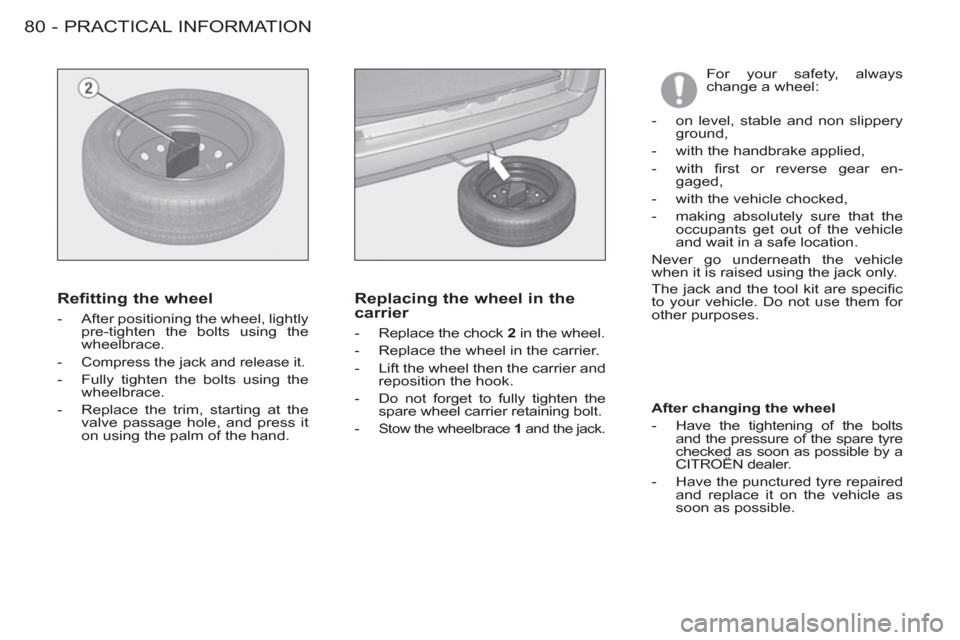
PRACTICAL INFORMATION
80 -
For your safety, always
change a wheel:
Refitting the wheel
- After positioning the wheel, lightly
pre-tighten the bolts using the
wheelbrace.
-
Compress the jack and release it.
- Fully tighten the bolts using the
wheelbrace.
- Replace the trim, starting at the
valve passage hole, and press it
on using the palm of the hand.
Replacing the wheel in the
carrier
- Replace the chock 2
in the wheel.
- Replace the wheel in the carrier.
- Lift the wheel then the carrier and
reposition the hook.
- Do not forget to fully tighten the
spare wheel carrier retaining bolt.
-
Stow the wheelbrace 1
and the jack.
After changing the wheel
- Have the tightening of the bolts
and the pressure of the spare tyre
checked as soon as possible by a
CITROËN dealer.
- Have the punctured tyre repaired
and replace it on the vehicle as
soon as possible.
- on level, stable and non slippery
ground,
- with the handbrake applied,
- with fi rst or reverse gear en-
gaged,
- with the vehicle chocked,
- making absolutely sure that the
occupants get out of the vehicle
and wait in a safe location.
Never go underneath the vehicle
when it is raised using the jack only.
The jack and the tool kit are specifi c
to your vehicle. Do not use them for
other purposes.
Page 88 of 128
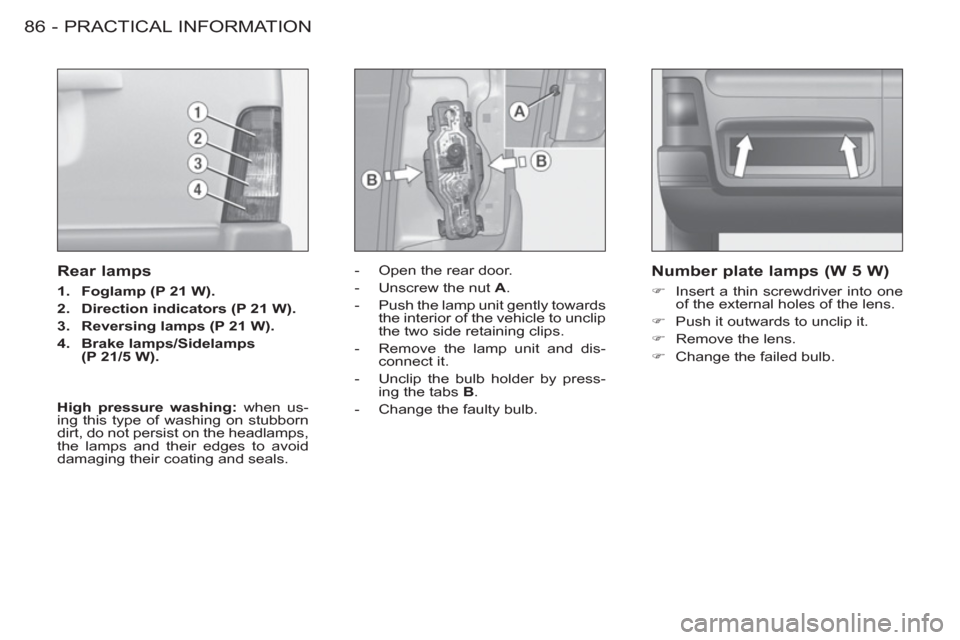
PRACTICAL INFORMATION
86 -
- Open the rear door.
- Unscrew the nut A
.
- Push the lamp unit gently towards
the interior of the vehicle to unclip
the two side retaining clips.
- Remove the lamp unit and dis-
connect it.
- Unclip the bulb holder by press-
ing the tabs B
.
- Change the faulty bulb.
Number plate lamps (W 5 W)
�)
Insert a thin screwdriver into one
of the external holes of the lens.
�)
Push it outwards to unclip it.
�)
Remove the lens.
�)
Change the failed bulb.
Rear lamps
1.
Foglamp (P 21 W).
2.
Direction indicators (P 21 W).
3.
Reversing lamps (P 21 W).
4.
Brake lamps/Sidelamps
(P 21/5 W).
High pressure washing:
when us-
ing this type of washing on stubborn
dirt, do not persist on the headlamps,
the lamps and their edges to avoid
damaging their coating and seals.
Page 96 of 128

PRACTICAL INFORMATION
94 -
SNOW SCREEN *
The snow screen is installed on the
lower part of the front bumper to pre-
vent the accumulation of snow at the
radiator cooling fan.
Remove the snow screen:
- when the exterior temperature is
higher than 10 °C,
- when towing,
- for speeds higher than 75 mph
(120 km/h).
FITTING
�)
Offer up the snow screen facing
the front bumper.
�)
Put it in place positioning the lower
clips A
in the bumper.
�)
Press the snow screen at each
upper clip B
.
REMOVAL
�)
Press the two upper clips B
and
pull the snow screen.
*
As an accessory or according to country.
Page 97 of 128

95 PRACTICAL INFORMATION
-
Without lifting
(four wheels on the ground)
You must always use a towbar.
By lifting
(two wheels only on the ground)
It is preferable to lift the vehicle by
the wheels.
TOWING YOUR VEHICLE
From the front or the rear
Attach the towbar to the towing eye.
Never use the radiator cross-
member.
When towing another vehicle,
it must freewheel.
Place the gearbox in "neutral".
Failure to observe this instruction
may result in damage to certain brak-
ing components and the absence of
braking assistance when the engine
is started again.
Page 98 of 128
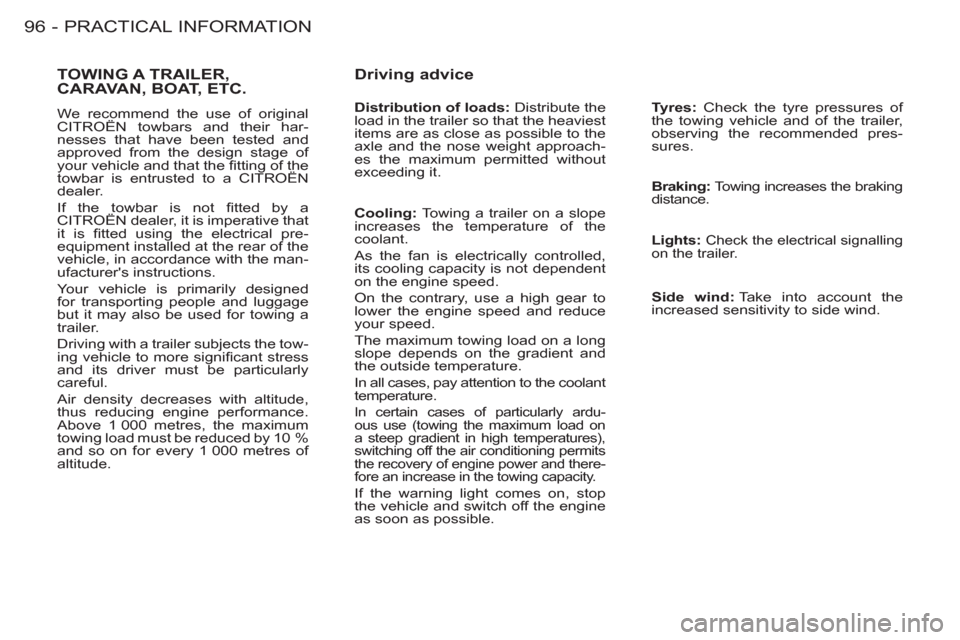
PRACTICAL INFORMATION
96 -
TOWING A TRAILER,CARAVAN, BOAT, ETC.
We recommend the use of original
CITROËN towbars and their har-
nesses that have been tested and
approved from the design stage of
your vehicle and that the fi tting of the
towbar is entrusted to a CITROËN
dealer.
If the towbar is not fi tted by a
CITROËN dealer, it is imperative that
it is fi tted using the electrical pre-
equipment installed at the rear of the
vehicle, in accordance with the man-
ufacturer's instructions.
Your vehicle is primarily designed
for transporting people and luggage
but it may also be used for towing a
trailer.
Driving with a trailer subjects the tow-
ing vehicle to more signifi cant stress
and its driver must be particularly
careful.
Air density decreases with altitude,
thus reducing engine performance.
Above 1 000 metres, the maximum
towing load must be reduced by 10 %
and so on for every 1 000 metres of
altitude.
Driving advice
Tyres:
Check the tyre pressures of
the towing vehicle and of the trailer,
observing the recommended pres-
sures.
Cooling:
Towing a trailer on a slope
increases the temperature of the
coolant.
As the fan is electrically controlled,
its cooling capacity is not dependent
on the engine speed.
On the contrary, use a high gear to
lower the engine speed and reduce
your speed.
The maximum towing load on a long
slope depends on the gradient and
the outside temperature.
In all cases, pay attention to the coolant
temperature.
In certain cases of particularly ardu-
ous use (towing the maximum load on
a steep gradient in high temperatures),
switching off the air conditioning permits
the recovery of engine power and there-
fore an increase in the towing capacity.
If the warning light comes on, stop
the vehicle and switch off the engine
as soon as possible.
Distribution of loads:
Distribute the
load in the trailer so that the heaviest
items are as close as possible to the
axle and the nose weight approach-
es the maximum permitted without
exceeding it.
Braking:
Towing increases the braking
distance.
Lights:
Check the electrical signalling
on the trailer.
Side wind:
Take into account the
increased sensitivity to side wind.
Page 99 of 128
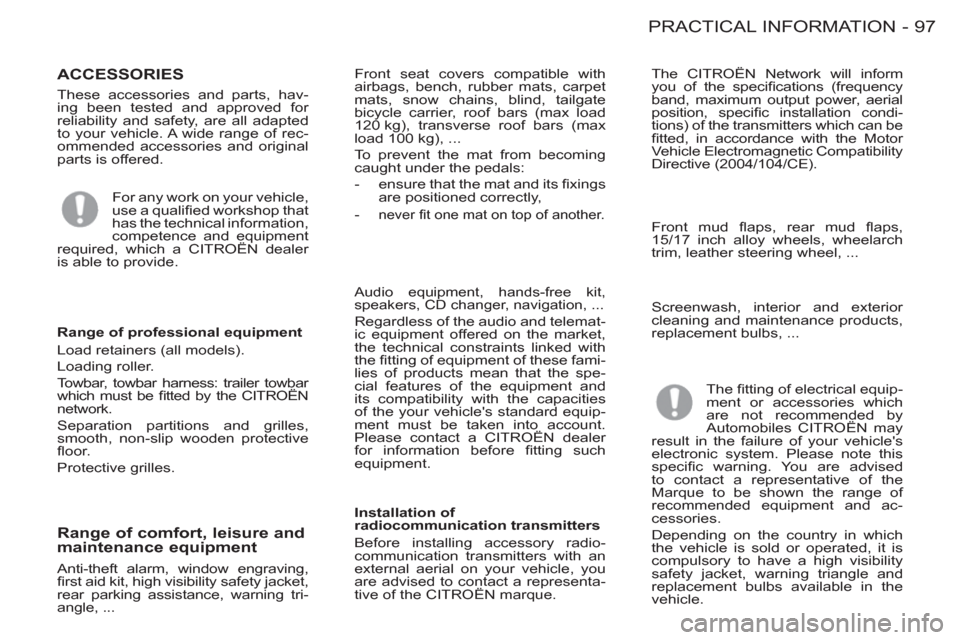
97 PRACTICAL INFORMATION
-
ACCESSORIES
These accessories and parts, hav-
ing been tested and approved for
reliability and safety, are all adapted
to your vehicle. A wide range of rec-
ommended accessories and original
parts is offered.
The fi tting of electrical equip-
ment or accessories which
are not recommended by
Automobiles CITROËN may
result in the failure of your vehicle's
electronic system. Please note this
specifi c warning. You are advised
to contact a representative of the
Marque to be shown the range of
recommended equipment and ac-
cessories.
Depending on the country in which
the vehicle is sold or operated, it is
compulsory to have a high visibility
safety jacket, warning triangle and
replacement bulbs available in the
vehicle.
Screenwash, interior and exterior
cleaning and maintenance products,
replacement bulbs, ...
Anti-theft alarm, window engraving,
fi rst aid kit, high visibility safety jacket,
rear parking assistance, warning tri-
angle, ...
Audio equipment, hands-free kit,
speakers, CD changer, navigation, ...
Regardless of the audio and telemat-
ic equipment offered on the market,
the technical constraints linked with
the fi tting of equipment of these fami-
lies of products mean that the spe-
cial features of the equipment and
its compatibility with the capacities
of the your vehicle's standard equip-
ment must be taken into account.
Please contact a CITROËN dealer
for information before fi tting such
equipment.
Front mud fl aps, rear mud fl aps,
15/17 inch alloy wheels, wheelarch
trim, leather steering wheel, ...
Range of professional equipment
Load retainers (all models).
Loading roller.
Towbar, towbar harness: trailer towbar
which must be fi tted by the CITROËN
network.
Separation partitions and grilles,
smooth, non-slip wooden protective
fl oor.
Protective grilles.
Installation of
radiocommunication transmitters
Before installing accessory radio-
communication transmitters with an
external aerial on your vehicle, you
are advised to contact a representa-
tive of the CITROËN marque.
Range of comfort, leisure and
maintenance equipment
Front seat covers compatible with
airbags, bench, rubber mats, carpet
mats, snow chains, blind, tailgate
bicycle carrier, roof bars (max load
120 kg), transverse roof bars (max
load 100 kg), ...
To prevent the mat from becoming
caught under the pedals:
- ensure that the mat and its fi xings
are positioned correctly,
-
never fi t one mat on top of another.
For any work on your vehicle,
use a qualifi ed workshop that
has the technical information,
competence and equipment
required, which a CITROËN dealer
is able to provide. The CITROËN Network will inform
you of the specifi cations (frequency
band, maximum output power, aerial
position, specifi c installation condi-
tions) of the transmitters which can be
fi tted, in accordance with the Motor
Vehicle Electromagnetic Compatibility
Directive (2004/104/CE).
Page 107 of 128
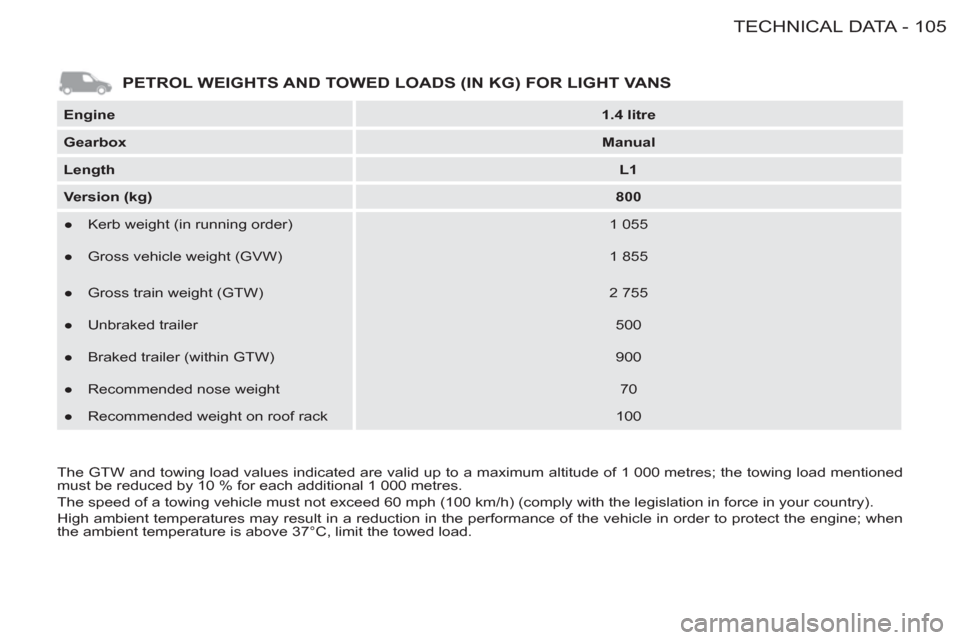
105 TECHNICAL DATA
-
Engine
1.4 litre
Gearbox
Manual
Length
L1
Version (kg)
800
●
Kerb weight (in running order)
1 055
●
Gross vehicle weight (GVW)
1 855
●
Gross train weight (GTW)
2 755
●
Unbraked trailer
500
●
Braked trailer (within GTW)
900
●
Recommended nose weight
70
●
Recommended weight on roof rack
100
The GTW and towing load values indicated are valid up to a maximum altitude of 1 000 metres; the towing load mentioned
must be reduced by 10 % for each additional 1 000 metres.
The speed of a towing vehicle must not exceed 60 mph (100 km/h) (comply with the legislation in force in your country).
High ambient temperatures may result in a reduction in the performance of the vehicle in order to protect the engine; when
the ambient temperature is above 37°C, limit the towed load.
PETROL WEIGHTS AND TOWED LOADS (IN KG) FOR LIGHT VANS